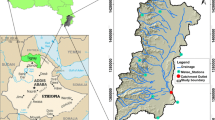Abstract
Quantification of groundwater recharge is important for water resources management. Different methods can be used to estimate groundwater recharge. The most suitable approach depends on site characteristics. Water balance model was used in this study to quantify groundwater recharge from rainfall in Ruataniwha Basin, Hawke’s Bay, New Zealand. Because it is a closed basin, this method was determined to be more suitable than any other method. The basin is fed by surface water flow and rainfall, without any lateral groundwater flow. Records of surface water inflow and outflow are available with a certain degree of reliability. To cope with uncertainty in different components of water balance, different sampling methods were used. The Mean Value Latin Hypercube Sampling (MVLHS) was used and compared with Latin Hypercube Sampling (LHS), and Monte Carlo Simulation (MCS). It was found the groundwater recharge from rainfall is about 415 million m3/year. Results of this study have revealed that MVLHS converges faster and with lower variance than LHS and MCS.





Similar content being viewed by others
References
Baalousha H (2005) Using CRD method for quantification of groundwater recharge in the Gaza Strip, Palestine. J Environ Geol 48(7):889–900
Batelaan O, De Smedt F (2007) GIS-based recharge estimation by coupling surface–subsurface water balances. J Hydrol 337(3–4):337–355
Bazuhair A, Wood W (1996) Chloride mass-balance method for estimating ground water recharge in arid areas: examples from western Saudi Arabia. J Hydrol 186(1–4):153–159
Bekesi G, McConchie J (1999) Groundwater recharge modelling using the Monte Carlo technique, Manawatu region, New Zealand. J Hydrol 224:137–148
Benson C, Abichou T, Albright W, Gee G, Roesler A (2001) Field evaluation of alternative earthen final covers. Int J Phytoremediation 3(1):105–127
Francis D (2001) Subsurface geology of the Ruataniwha Plains and relation to hydrology. Technical report. Geological Research Ltd, Lower Hutt
Geea G, Zhanga Z, Tylerb S, Albrightb W, Singletonc M (2005) Chloride Mass Balance Cautions in Predicting Increased Recharge Rates. Vadose Zone J 4(1):72–78
Hardyanto W, Merkel B (2007) Introducing probability and uncertainty in groundwater modeling with FEMWATER-LHS. J Hydrol 332(1–2):206–213
Houston J (2007) Recharge to groundwater in the Turi Basin, northern Chile: an evaluation based on tritium and chloride mass balance techniques. J Hydrol 334(3–4):34–544
Iman R, Helton J (1988) An investigation of uncertainty and sensitivity techniques for computer models. Risk Anal 8(1):71–90
Keramat M, Kielbasa R (1999) Modified Latin hypercube sampling Monte Carlo (MLHSMC) estimation for average quality index. Analog Integr Circuits Signal Proc 19(1):87–98
Kuczera G, Prent E (1998) Monte Carlo assessment of parameter uncertainty in conceptual catchment models: the metropolis algorithm. J Hydrol 211(1):69–85
Le Gal La Salle C, Marlin C, Leduc C, Taupin J, Massault M, Favreau G (2001) Renewal rate estimation of groundwater based on radioactive tracers (3H, 14C) in an unconfined aquifer in a semi-arid area, Iullemeden Basin, Niger. J Hydrol 254(1–4):145–156
Lincoln Environmental (2002) Ruataniwha Plain water management stage 1: potential irrigation demand Lincoln environmental report No. 4477/2 prepared for Hawke’s Bay Regional Council
Lioua T, Der Yeh H (1997) Conditional expectation for evaluation of risk groundwater flow and solute transport: one dimensional analysis. J Hydrol 199(3–4):378–402
Ludecke J (1988) The Tukituki river catchment. Water and soil resource management plan. Hawke’s Bay Catchment Board and Regional Water Board
McKay M, Beckman R, Conover W (1979) Comparison of three methods for selecting values of input variables in the analysis of output from a computer code. Technometrics 21(2):239–245
Murray L (2002) Modelling Ruataniwha plains groundwater. Report prepared for Hawke’s Bay Regional Council
Owen A (1992) Orthogonal array for computer experiments, integration and visualization. Stat Sin 2(2):439–452
Owen A (1998) Latin supercube sampling for very high dimensional simulations. Modeling and computer simulation. ACM Transac Model Comput Simul 8(2):71–102
Sami K, Hughes D (1996) A comparison of recharge estimates to a fractured sedimentary aquifer in South Africa from a chloride mass balance and an integrated surface-subsurface model. J Hydrol 179(1–4):111–136
Sharma ML, Hughes MW (1985) Groundwater recharge estimation using chloride, deuterium, and oxygen-18 profiles in the deep coastal sands of Western Australia. J Hydrol 81(1–2):93–109
Stein M (1987) Large sample properties of simulations using Latin hypercube sampling. Technometrics 29(2):43–151
Szilagyi J, Harvey FE, Ayers JF (2003) Regional estimation of base recharge to ground water using water balance and a base-flow index. Ground Water 41(4):504–513
Thompson C (1987) The climate and weather of Hawke’s Bay, 2nd edn, vol 115(5). New Zealand Meteorological Service Misc Publ, Wellington
Ting C, Kerh T, Liao C (1998) Estimation of groundwater recharge using the chloride mass-balance method, Pingtung Plain, Taiwan. Hydrogeol J 6(2):282–292
Wright KA, Xu Y (2000) A water balance approach to the sustainable management of groundwater in South Africa. Water SA 26(2):167–170
Author information
Authors and Affiliations
Corresponding author
Rights and permissions
About this article
Cite this article
Baalousha, H. Stochastic water balance model for rainfall recharge quantification in Ruataniwha Basin, New Zealand. Environ Geol 58, 85–93 (2009). https://doi.org/10.1007/s00254-008-1495-6
Received:
Accepted:
Published:
Issue Date:
DOI: https://doi.org/10.1007/s00254-008-1495-6




